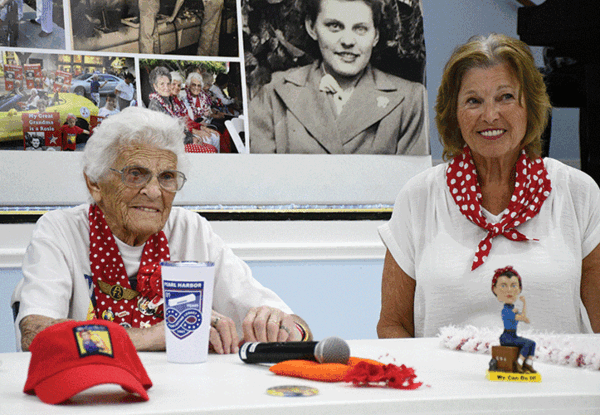 Winter Texan earns unique honors
Winter Texan earns unique honors
By Barb Zanetti
Photos by Dennis Zanetti
Alamo Palms’ 98-year-old Louise Unkrich didn’t have white hair when she did the work that would bring her national recognition. Actually, she was a dark-haired teenager.
Typical of other young women whose lives changed course in the early 1940’s, Louise left her Swedesburg, Iowa hometown at 19 to find meaningful work about 250 miles away. Her job would be to assemble parts for B-26’s and B-29’s at the Glenn L. Martin bomber plant south of Omaha, near Bellevue, Nebraska.
“The war was on,” she said. “My boyfriend was in the Navy, and I wanted to help.”
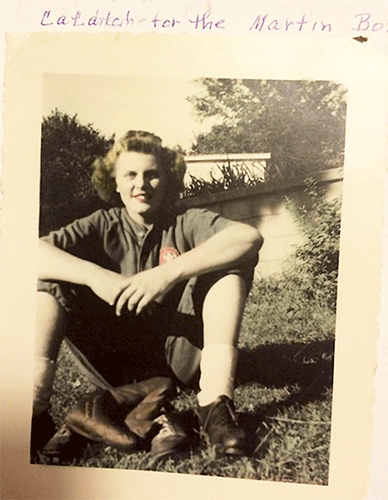 A Focus on the Job
A Focus on the Job
When Louise first arrived, she joined four other women who were “grateful” to sleep on cots set up on a local family’s enclosed porch. They were driven to work by the homeowner, who also worked at the new 17,000,000 sq. ft. plant at Fort Crook, now Offutt Airforce Base. It would be a few months until Louise would move into a room in another family’s home.
To earn the 70¢-an-hour starting union wage with no benefits, she stood for eight hours a day assembling ailerons. (She described this airplane part as a 10-foot aluminum flap on the wing’s back edge toward its tip. Ailerons move up and down to allow the pilot to control the plane’s horizontal movement, as well as its speed.)
Each aileron consisted of three parts with approximately 1,000 pre-drilled holes.
Once its aluminum “skins” or pieces were overlapped and their holes lined up, the aileron’s parts were fastened by a riveter on one side and a bucker on the other until the elongated, tuna-shaped flap took shape.
On her four-person team (two women and two men), Louise worked as the “bucker.” That meant she held a 4x2x2-inch steel bar against the back of each pre-drilled hole. When a large aluminum rivet was air-gunned through the hole, it squashed against her bar.
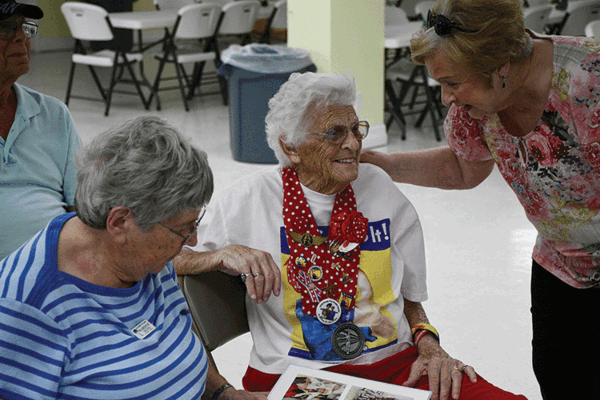 Louise said that if she didn’t hold the bar perfectly flat, the back of the rivet wouldn’t be flattened evenly, and the rivet would need to be drilled out and re-driven. Workers were well aware that mistakes slowed the war effort.
Louise said that if she didn’t hold the bar perfectly flat, the back of the rivet wouldn’t be flattened evenly, and the rivet would need to be drilled out and re-driven. Workers were well aware that mistakes slowed the war effort.
She said her hands were often very sore from holding the bar during the repetitive work. But she said, “I had a job to do, and I did it.”
What Louise liked best about that job was “working with the team and making something worthwhile.”
Wartime Recognition
Employing over 14,500 workers at peak production, the Martin plant would earn much recognition.
She said there was a lot to be proud of at her workplace.
On a personal level, Louise’s four-person team assembled an aileron in one eight-hour shift, setting a plant record.
The bomber-building plant itself earned “White Star” awards from the military for on-time production.
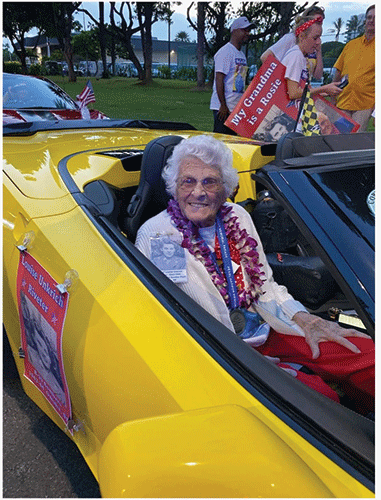 Because of the plant’s reputation for quality work, Lt. Col. Paul Tibbets, Jr. visited the Martin assembly line to choose the B-29 Superfortress he would pilot over Japan. From that plane, his crew dropped the first atomic bomb on Hiroshima.
Because of the plant’s reputation for quality work, Lt. Col. Paul Tibbets, Jr. visited the Martin assembly line to choose the B-29 Superfortress he would pilot over Japan. From that plane, his crew dropped the first atomic bomb on Hiroshima.
In his autobiography, he said, “I looked upon this airplane as one of the best B-29’s ever produced.” (He named that aircraft “Enola Gay” after his mother.)
Louise said she can understand why he complimented the quality of work at the Glenn L. Martin plant.
“We all tried to do our very best when I was there,” she explained about the expected work ethic. “If something needed to be done, you went and did it. You didn’t think about it.”
Life-changing Phone Call
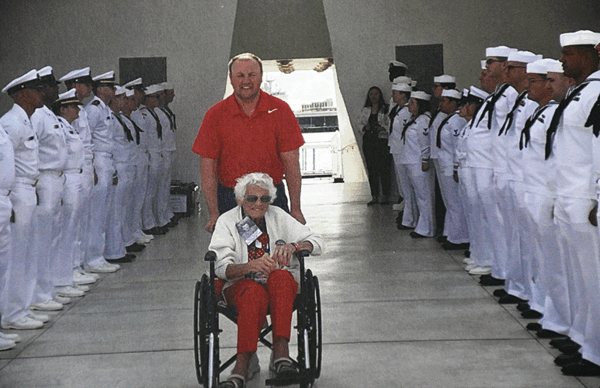 After 18 months of riveting and buckering at the plant, Louise got a phone call from her long-time boyfriend Clarence. He had a special request. He said he could get a leave from the Navy if he was married.
After 18 months of riveting and buckering at the plant, Louise got a phone call from her long-time boyfriend Clarence. He had a special request. He said he could get a leave from the Navy if he was married.
She quit her wartime job.
Five days later, the two of them exchanged vows in the Swedesburg Evangelical Lutheran Church. Together they left for Rhode Island, where he continued his officer’s training for three months until his ship was ready to be christened in Providence.
Then he was off to the Pacific, and she wouldn’t see her husband for another year.
Back Home to a Different Life
Meanwhile her father and father-in-law needed her help on their Iowa farms, so she headed back home to become what she described as a “farmhand,” a position she said she would hold for the next 60 years.
The war ended. Clarence came home. They worked the farm and had three children: Patricia “Trish,” Stan, and Julia.
She helped her family sow and cultivate crops, and then assisted her husband in operating his new project – a grain elevator.
According to her family and friends, Louise was much more than a “farmhand,” although she was still driving a tractor well into her 90s.
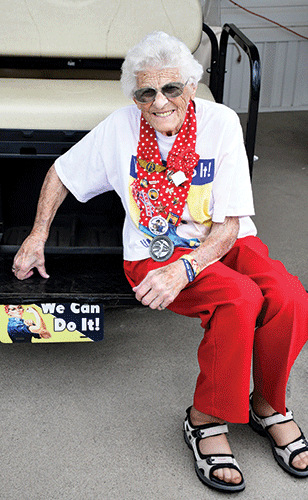 They said she was busy adding value to lives around her.
They said she was busy adding value to lives around her.
For her community, she founded and became the director of a Swedish American Museum so that early Swedesburg settlers’ tools and experiences could be preserved.
For her church, she served as one of the first three women in the Evangelical Lutheran Church Council and became active in its various groups and activities.
Along the way, Louise earned state recognition when she was named “Iowan of the Day” at the Iowa State Fair.
For enjoyment, she delighted in having visited all 50 states. She also became a world traveler visiting Canada, Mexico, Africa, Europe and making at least nine trips to Sweden.
For many, such a lauded life story would have meant satisfying success. But it didn’t stop there for Louise.
New Life as a ‘Rosie’
Over 50 years after World War II ended, Dr. Frances Carter of Birmingham, Alabama, established the “American Rosie the Riveter Association” to recognize and preserve the history and legacy of women who had worked doing jobs that most men had done. These women became known as “Rosies*.”
Over 10 years ago, Louise became an active Rosie the Riveter Association member. And her life changed course again.
In typical Louise fashion, she wasn’t content to be a joiner. She established Iowa’s Rosie chapter and, together with her daughters Patricia and Julia, organized the state’s first convention.
According to Patricia, the Rosie group offers her mother support and a unique camaraderie that her father already had.
“For women Rosies it was: ‘You do your job and go home’,” she said. In contrast, “For 25 years my dad went to his annual ship’s reunion.”
 More Recognition
More Recognition
Louise continued to promote the Rosie organization that offered her a unique glimpse at the lives of other working women during World War II.
In 2016, Louise was featured as the August “Rosie” (Washington State’s chapter calendar).
Four years later, she with the other original Rosies, were awarded the United States’ highest civilian honors.
According to the Dec. 8, 2020, Smithsonian Magazine, “Forever changing the nation, the women who worked in American factories during [World War II] have collectively been awarded the Congressional Gold Medal.”
But Louise wasn’t done being recognized for her Rosie role.
On Dec. 7, 2022, she joined four other original Rosies as VIP’s at the 81st Pearl Harbor Memorial Day in Honolulu, Hawaii. There they were honored guests in the parade and at a memorial service held on the USS Arizona.
Sharing Her Rosie Life
Along with her daughter Patricia, Louise related her “Rosie” story to friends and neighbors at Alamo Palms RV Resort in a mid-March afternoon program.
After the presentation, residents applauded Louise’s service and tenacity. One by one they complimented her. “She’s a treasure.” “Feisty.” “A positive force.” “Valued.”
Those closest to her agreed.
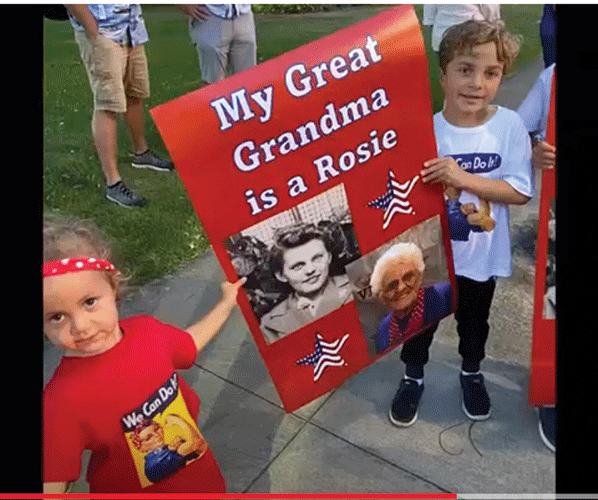 “Louise will look for a task that needs to be done and will do anything to fill that need, whether it’s small or large,” resident Martha Smith said. “Louise is our friend, and we are honored to know her.”
“Louise will look for a task that needs to be done and will do anything to fill that need, whether it’s small or large,” resident Martha Smith said. “Louise is our friend, and we are honored to know her.”
Many said they are amazed at her life story, … especially the impact 18 months of dedicated work as a teenager has had on the 98-year-old’s life.
And for Louise … that time as a teen seems to have made all the difference.
* “Rosies” were named after the “Rosie the Riveter” poster. (The “We Can Do It” slogans were meant to encourage women to work harder at what were once men’s jobs.)














